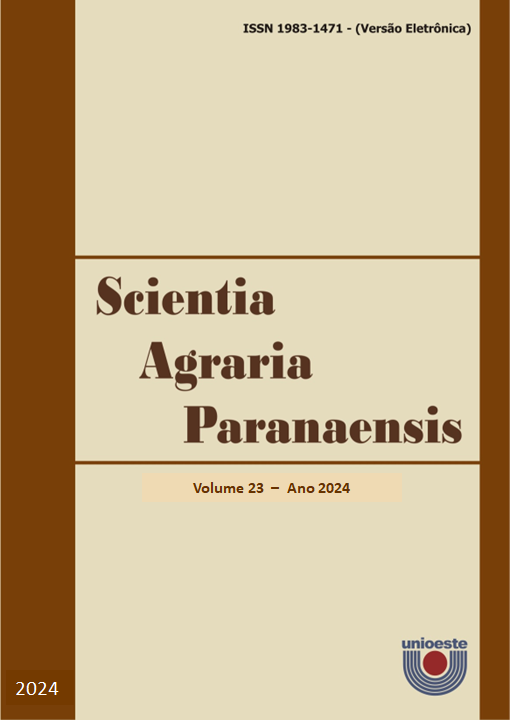Adding of Tifton-85 hay to whole grain corn-based diets for growing cattle
Efeito da adição de feno de Tifton-85 (Cynodon spp.) a dietas à base de milho integral para bovinos em crescimento
DOI:
https://doi.org/10.18188/sap.v23.33084Resumo
Advancements in ruminant nutrition have optimized productive efficiency in feedlot systems, reducing operational costs and enhancing animal performance. Understanding the impact of forage-free diets, such as whole corn grain usage, is essential to maximizing starch digestibility and minimizing nutritional losses. The objective of this study was to investigate the effects of adding Tifton-85 hay (Cynodon spp.) as a source of fiber on the consumption, digestibility and recovery of undegraded corn in feces in diets of growing cattle based on whole grain corn. The experiment was carried out in two simultaneous Latin squares, using 8 Holstein x Gir crossbred calves. The treatments consisted of four whole grain corn diets: the control treatment (F0) consisted of a diet without roughage, containing 85% whole grain corn and 15% pellets (pelletized supplement), in addition to the inclusion of three levels of hay. Tifton-85: 0.2% (F2); 0.4% (F4) and 0.8% (F8) of body weight. The inclusion of hay had no impact on dry matter intake, protein intake and mineral matter intake. No significant differences were observed in dry matter digestibility, protein digestibility and mineral matter digestibility. However, there was a significant increase in the consumption of neutral detergent fiber and its digestibility. The addition of hay resulted in a reduction in the amount of corn present in feces, indicating greater breakdown of the corn due to chewing. Furthermore, there was a lower percentage of corn retained in feces on the 4mm sieve. These results suggest that the inclusion of hay in whole corn-based diets may be a viable nutritional strategy to increase dietary energy efficiency.
Downloads
Publicado
Como Citar
Edição
Seção
Licença
Aviso de Direito Autoral Creative Commons
Política para Periódicos de Acesso Livre
Autores que publicam nesta revista concordam com os seguintes termos:
1. Autores mantém os direitos autorais e concedem à revista o direito de primeira publicação, com o trabalho simultaneamente licenciado sob a Licença Creative Commons Attribution que permite o compartilhamento do trabalho com reconhecimento da autoria e publicação inicial nesta revista.2. Autores têm autorização para assumir contratos adicionais separadamente, para distribuição não-exclusiva da versão do trabalho publicada nesta revista (ex.: publicar em repositório institucional ou como capítulo de livro), com reconhecimento de autoria e publicação inicial nesta revista.
3. Autores têm permissão e são estimulados a publicar e distribuir seu trabalho online (ex.: em repositórios institucionais ou na sua página pessoal) a qualquer ponto antes ou durante o processo editorial, já que isso pode gerar alterações produtivas, bem como aumentar o impacto e a citação do trabalho publicado (Veja O Efeito do Acesso Livre).
Licença Creative Commons
Esta obra está licenciada com uma Licença Creative Commons Atribuição-NãoComercial-CompartilhaIgual 4.0 Internacional, o que permite compartilhar, copiar, distribuir, exibir, reproduzir, a totalidade ou partes desde que não tenha objetivo comercial e sejam citados os autores e a fonte.


